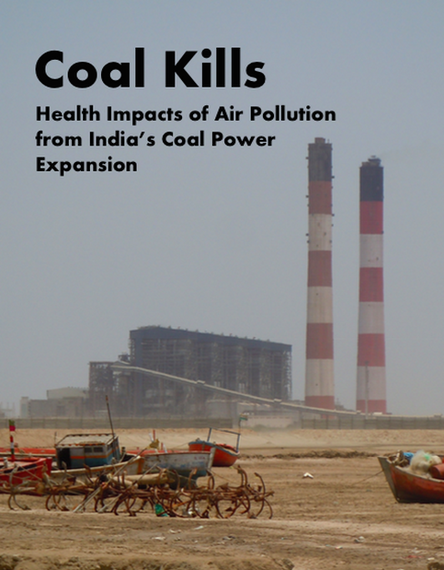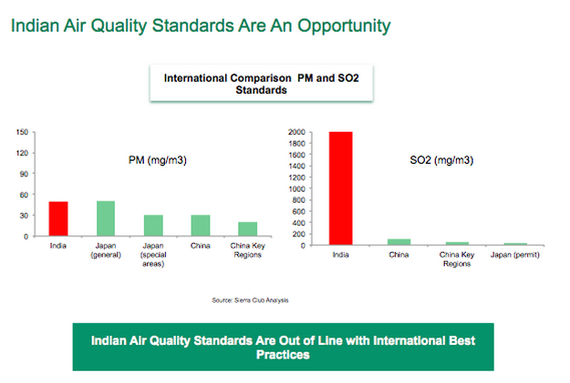
That’s the stark findings of the latest report from India-based Conservation Action Trust and Urban Emissions. A year ago, these groups released a groundbreaking report that estimated for the first time the human toll from India’s dirtiest fuel source. They found a shocking 80,000-115,000 people were dying every year as a result of air pollution from coal-fired power plants.
But this time around they have much more dire news. Their new report has found that if all proposed coal plants are built, India is facing up to 229,000 annual deaths – a 100 percent increase.
Given the dramatic and abrupt change China’s catastrophic air pollution has driven, including a historicclimate pact with the United States, Indian policymakers are right to take heed of the bleak future laid out in this report. But for that outcome to be avoided, steps need to be taken now to curb the worst effects of an overreliance on coal. That includes reducing the enormous pipeline of new coal-fired power plants the country has planned and setting strict air quality standards for new and existing coal plants that are in line with the international community.
India however, lags far behind even China when it comes to air quality standards. Previous analysis (see analysis here) revealed that Indian standards are anywhere between four and 20 times worse than those in China.
Yes, you read that right, China — home to the original “airpocalypse” — has stronger coal plant pollution standards than India.
It turns out Indian standards are quite literally off the charts (Check out the comparison below). That’s because India doesn’t even have coal plant pollution standards for sulfur dioxide or nitrogen oxides – both of which lead to deadly Particulate Matter (PM) 2.5 pollution (A quick note: Since India does not have actual standards, the charts below use ‘nominal’ figures to show what emissions from an uncontrolled coal plant might look like).

Even worse though, the standards India does employ for particulate matter are nearly two times worse than their Chinese counterparts (see the chart on PM emissions referenced above). It’s also widely known that monitoring and implementation of these weak standards is next to non-existent.
Debi Goenka of Conservation Action Trust, bewildered by policymakers’ approach to Indian emission standards, said, “They are either absent or shamefully behind those of even China. Does the Ministry of Environment consider Indian lives to be less valuable?”
Clearly not, but if Indian policymakers do not act they may find themselves in the undignified position of inheriting the mantle of “airpocalypse” from China. That includes the kind of international embarrassment and scrutiny that heaped additional pressure on China, already reeling from what it considered a threat to social stability.
But in every threat lies opportunity.
It turns out that many Indian elites are increasingly wary of India’s overreliance on coal to power its development. Take EAS Sarma, former Minister of Power: “Clearly, it is time for us to halt coal mining to pre-empt further human misery and environmental degradation,” or former Minister of Environment and Forests Jairam Ramesh: “Actually we have no option but to ensure that non-fossil energy sources expand aggressively in the years ahead.”
Some Indian think tanks have called for a complete moratorium on new coal-fired power plants due to overwhelming environmental effects.
But while resistance may be brewing, it’s quite clear Prime Minister Narendra Modi runs the show. That means that all the increased pressure for India to adjust its increasingly anachronistic stance on coal falls at his feet. With world leaders meeting this week in Lima, Peru at the annual United NationsConference of Parties (COP) — COP20 — on the road to a potential climate deal next year in Paris at the COP21, the world is wondering will Prime Minister Modi rise to the challenge?
The truth is that the looming airpocalypse in India puts the world in a very interesting place. The international pressure Prime Minister Modi now faces was largely made possible by China’s own struggles with air pollution, which played a dramatic and decisive role in enabling the country’s leadership to establish strict new curbs on coal use and sign a landmark deal with the United States on climate. In essence, air pollution unlocked action on climate.
If Prime Minister Modi is to measure up to this level of international leadership, as well as the image he projects, he’ll need to be bold. After all, he sees himself as anything but the average bureaucrat – he’s someone who cuts through red tape and gets things done. The very last thing someone like that would do on the world’s stage is leave the plight of average Indians unresolved, or to act as an obstacle, a petty bureaucrat, standing in the way of international progress.
Of course Prime Minister Modi is already well-placed to seize this opportunity with the ambitious solar goals he has already laid out – 100-gigawatts of new solar and solar power for all by 2019. Actually delivering on those goals alone would make Prime Minister Modi worthy of international praise. But to truly avoid a Chinese fate, he simply must address the growing problem India’s coal reliance has and will become.
Already, interesting signs are afoot that Prime Minister Modi will move. President Obama is planning to visit on the country’s Republic Day, spurring rumors of a new announcement on a peaking year for greenhouse gas emissions ahead of his visit. At the same time, new air pollution standards for coal plants are rumored to be coming soon. Both of these would provide a serious means for addressing this issue.
However it plays out, it’s quite clear: For Prime Minister Modi, this is about seizing an opportunity to address a primarily domestic problem – air pollution – and garnish global praise in the process. The domestic co-benefits alone justify such action. All of which means for Prime Minister Modi, and the world, India’s own air pollution curse may be a blessing in disguise.
http://theenergycollective.com/guayjguay/2169721/indias-airpocalypse-could-kill-229000-people-every-year
Leave a Reply